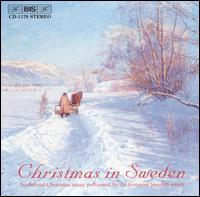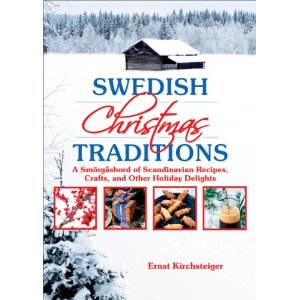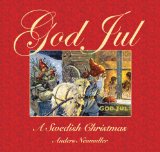|
Christmas in SwedenChristmas in Sweden, more than any other holiday, is the time for sentiment and joy. Stored feelings come out in the open and the freedom to express what is in the heart is joyously embraced. There is no need to fear being considered emotional or sentimental, because everyone is prompted by the same feelings. This release of emotions makes for a warmer companionship, and at no other time of year are there such gratifying attachments formed as at Christmas. Formality is put on the shelf – and Swedish formality can be strong – letting the Christmas spirit take over. To the children the anticipation is almost unbearable. They count the days – the day before the day, before the day . . . – until at last the day itself arrives, Christmas Eve. That is the day of climax in Sweden as in the rest of Scandinavia, not Christmas Day. Weeks of scrubbing, weeks of baking, weeks of cooking terminate with this day. The house smells Christmas! The Christmas tree is brought inside and with it fresh air and the fresh scent of pine. The children flock around father as he puts the star at the top of the tree and mother searches through boxes for the familiar trimmings and ornaments. Garlands of small Swedish blue and yellow flags are common, and if the family has relatives in other countries such as the United States there will be garlands of small flags from those countries too. The Swedish Dopp I gryta must for all practical reasons be enjoyed in the kitchen. Serving the meal buffet style facilitates the ceremonial procedure in front of the stove where members of the household now gather to dip their bread in the pot or gryta, that is, in the hot broth. The custom goes back to pagan days, it is told, when the Vikings at the time of the winter solstice, and dreary with the darkness, sacrificed to the sun by fasting, that is, refraining from eating meat and making a meal of bread and broth only. One can assume that the thick broth yielded enough strength for husky bodies.
Say Merry Christmas in Swedish: God Jul In this collection you will find over 300 holiday postcard images to bring Sweden’s Christmas traditions to life. The charm, warmth, and beauty of a Swedish Christmas is captured in this remarkable collection of 300 colorful, fun, and historic postcards dating back to the 1800s. Each postcard reveals the magic behind Christmas, Scandinavian tradition and folklore. Here, the tomte/nisse meets Santa and children play with angels. With traditional postcards from renowned artists such as Jenny Nystrom, Elsa Beeskow, and Aina Stenberg, accompanied by explanations of the cultural and historical past, God Jul will make everyone that is even a little bit Swedish homesick for an Old World Christmas.
From a very old christmas story comes this description of Christmas in Sweden: In Sweden there is a general house-cleaning before Christmas; everything must be polished, scrubbed, beaten, and made clean, and all rubbish burned, for dirt, like sinful thoughts, cannot be tolerated during the holy festival. Christmas in Sweden - preparations As early as the first of December each housewife starts her preparations for the great day. Many have worked all the year making gifts for the occasion, but now the carpets must come up and be beaten, the paint must be cleaned, and the house set in order. 
Above is an album of swedish singing of christmas favorites, the now world famous Peter Mattei is featured along with choral singing of the first rank. You will be pleased to hear it! The silver which has been handed down from generation to generation, together with that received on holidays and birthdays, has to be cleaned and polished, so must the brasses-the tall fire-dogs, the stately andirons, and the great kettles-all must be made to reflect every changing ray of light. Christmas in Sweden - baking Then the baking for a well-ordered household is a matter of great moment, and requires ample time. It is usual to begin at least two weeks before Christmas. Bread is made of wheat and rye flour, raised over night, then rolled very thin and cut into discs twelve or fourteen inches in diameter, with a hole in the center. After having been baked, these are strung on a stick and left to dry under the beams of the baking-room. As they will keep a long while, large quantities are made at this season in each household. Then follows the making of sweetened, soft, rye, wheat, and other breads, as well as the baking of the light yellow (saffron), the chocolate-brown, and thin gray-colored cakes, and those that are filled with custard. Christmas in Sweden - Christmas Drinks The preparing of Christmas drinks always requires the close attention of good dames, for there must be an inexhaustible supply of Christmas beer, made of malt, water, molasses, and yeast, and wine with almonds and spices, and various other decoctions. Then the cheese must be made ready, not only the usual sour kind, but the more delicious sweet cheese that is made of sweet milk boiled slowly for hours and prettily moulded. The Swedish wife is relieved of the burden of making pies, as her people know nothing about that indigestible mixture so acceptable to American palates. Christmas in Sweden - the Christmas Tree The festivities begin with the dressing of the tree the day before Christmas. In this the older members of the family, with friends and relatives, join with great gusto, preparing paper flowers with which to bedeck the tall evergreen tree which reaches from floor to ceiling. They cut long ribbons of colored paper for streamers, and make yards of paper fringe to wind with the tinsel among the boughs, from which are hung bright colored boxes of sweetmeats, fruit, and fancy balls. The children are, of course, excluded from the room and obliged to content themselves with repeating the tales of Santa Claus, (Christmas in Sweden is connected with "Tomten", the Swedish version of Santa Claus) as told by their elders. When a gift is offered in person, or, as is more generally the case, is thrown in the door suddenly by an unseen hand, there rings a merry Glad Frill (God Jul = Good Yule) meaning "Merry Christmas," for that is the wish of the preceding day or days, rather than of Christmas itself. Christmas in Sweden - Christmas Eve On Christmas Eve at early nightfall, when the colored candles are ablaze over the entire tree, and the great red ball of light shines from its topmost branches, the children are admitted to the room amidst a babel of shouts and screams of delight, which are increased upon the arrival of a veritable Santa Claus bestrewn with wool-snow and laden with baskets of gifts. On the huge sled are one or more baskets according to the number of bundles to be distributed in the family. Each bundle bears the name of the owner on its wrapper, together with funny rhymes and mottoes, which are read aloud for the amusement of all. Santa Claus always gives an abundance of valuable counsel and advice to the young folks as he bestows upon them his pretty gifts. After the distribution of gifts and the disappearance of Santa Claus, all join in dancing and singing around the tree simple, childish jingles such as the following: "Now is Christmas here again, Now is Christmas here again, After Christmas then comes Easter, Cheese and bread and Christmas beer, Fish and rice and Christmas cheer! -etc." One of the prettiest dances is that of "Cutting the Oats," in which girls and boys-there must be an extra boy-dance in a circle, singing: "Cut the oats, cut the oats, Who is going to bind them? That my dearest will have to do, But where will I find him? "I saw him last eve in the moonlight, In the moonlight clear and bright, So you take one and I'll take one, And he will be left without one." The boys represent the cutters and the girls the oats, and great merriment prevails as the cutters' arms encircle the waists of the pretty oats, leaving the unfortunate cutter, whom they all dance around, bowing scoffingly as they shout: "No one did want you, Poor sprite, no one wants you, You are left alone, You are left alone." Many of their games are similar to "Blind Man's Buff," "Hunt the Key," and "Hot and Cold," or "Hunt to the Music," the latter being one which by its modulations from pianissimo to forte indicate the hunters' nearness to the object sought for. The game of "Blind Feeding the Blind" causes much amusement among the juveniles; two players sit opposite each other blindfolded and endeavor to feed one another with spoonfuls of milk, and their mishaps are very entertaining to the on-lookers. Christmas in Sweden: Between the hours of ten and eleven comes the grand Christmas supper, when all adjourn to the dining-room to partake of the annual feast for which the housewives have long been preparing. The table is usually tastefully and often elaborately trimmed with flowers and green leaves. The corners of the long snow-white homespun cloth are caught up into rosettes surrounded with long calla or other leaves; possibly the entire edge of the table is bedecked with leaves and flowers. The butter is moulded into a huge yellow rose resting on bright green leaves, and the napkins assume marvelous forms under the deft fingers of the artistic housewives.

Christmas in Sweden - Swedish Christmas Traditions Christmas in Sweden evokes fond memories of delicious homemade breads and pastries, simple and beautiful wreaths and ornaments, and handmade crafts fashioned by the fire on a snowy day. Here readers will learn how to bring those warm traditions into their own homes, wherever they live. Included are instructions to make mulled wine, homemade peanut brittle, red candied apples, crisp pepparkakor, lightly browned Swedish meatballs, candles, wreaths, and more. Each recipe and project are accompanied by beautiful full-color photographs. From fashioning centerpieces to baking delicious cookies to hand-making Christmas tree ornaments, this book will inspire readers to rediscover the joys of a Scandinavian Christmas.
The Christmas mush (rice porridge) holds the first place in importance among the choice viands of the occasion; it is rice boiled a long while in milk and seasoned with salt, cinnamon, and sugar, and is eaten with cream. Several blanched almonds are boiled in the mush and it is confidently believed that whoever finds the first almond will be the first to be married. Christmas in Sweden - Customs While eating it, each one is expected to make rhymes about the rice and the good luck it is to bring them, and the most remarkable poetical effusions are in order on these occasions. The Christmas fish is to the Swede what the Christmas roast-beef is to the Englishman, an indispensable adjunct of the festival. The fish used resembles a cod; it is buried for days in wood ashes or else it is soaked in soda water, then boiled and served with milk gravy. Bread, cheese, and a few vegetables follow, together with a pudding made of salt herrings, skinned, boned, and cut in thin slices, which are laid in a dish with slices of cold boiled potatoes and hard-boiled eggs, covered with a dressing of cream, butter, and eggs-then baked and served hot. The fish, rice, and a fat goose are said to be served at every table on Christmas from that of the king to that of the commonest of his subjects. Christmas in Sweden - Christmas Morning Christmas morning opens with an early service in church, to which the older members of the family go in sled parties of from forty to fifty sleds, each drawn by one, two, or even three horses, over whose backs jingle rows of silver-toned bells. The sled parties are a special feature of Christmas in Sweden. They start out while the stars are still twinkling in the sky, and the lighted trees are illuminating the homes they pass. The day itself is observed with less hilarity than other days during the season; the "Second Christmas Day" or day following, being far gayer. Then begin the family parties, with the looking forward to the great Twelfth-Night ball, after which the children and young folks end their evening parties by untrimming the tree of their entertainer amidst peals of laughter, songs, and shouts. The tree, of course, has been supplied anew with candles, fruit, and candy. The first are blown out and the last two struggled for while the tree is drawn slowly toward the door out of which it is finally pitched by the merry crowd. Christmas in Sweden - Official Holidays The Swedes have four legal holidays at Yule, beginning the day previous to Christmas, and they make merry while they last. Besides having the Jul-gran or Christmas tree, each family places in the yard a pole with a sheaf of grain on top for the birds' Christmas dinner, a pretty custom of Christmas in Sweden and common to many other countries. Business is very generally suspended during Christmas in Sweden, the day following, Twelfth Day, and the twentieth day. "Do as your forefathers have done, and you can't do wrong," is said to be the motto of the Swedes. So the customs of their forefathers are strictly observed at Yule-tide - Christmas in Sweden. Svea, the feminine name of Sweden, the "Queen of the North," contains what is popularly believed to be the burial-places of Wodin, Thor, and Freya. The mounds are about one mile from Upsala and are visited by travelers from all parts of the world. Antiquarian researchers, however, have recently had a word to say in doubt whether these mounds contain the remains of the renowned beings, those ancient travelers. The Swedes, however, still cling to the belief that the bones of Wodin, the Alexander of the North, rest beneath the sod at Upsala. In these mounds have been found the bones of a woman and of a dog, a bracelet of filigree work, and a curious pin shaped like a bird, but no sign of Wodin's presence. Yet peasants believe that Wodin passes by on dark nights, and his horse's shoe, with eight nail-holes, is exhibited in the museum at Utwagustorp. New Year's Day is of comparatively little importance; the Christmas trees are usually relighted for the enjoyment of the poorer children and gifts are made to the needy. The Yule festivities are prolonged for two weeks in many places, during which the people visit from home to home and enjoy many social pleasures. The devout attend church services each day, abandon all work so far as possible, and on January thirteenth generally finish up the joyous season with a ball.
Christmas in Sweden
|

